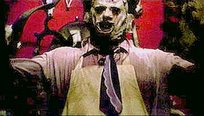 I'm not sure that in the history of film, one has been so unfairly maligned as The Texas Chainsaw Massacre. Yes, it's a disturbing film. Yes, it's frightening and will probably cause someone watching it for the first time to ask themselves why they are still continuing to watch. But, these aren't the reasons the film is so usually attacked by critics and the rising tide of people claiming movies are too violent these days. It's usually under the auspices of "what about the children", but let's be honest, it's always about adults trying to censor each others viewing and listening habits.
I'm not sure that in the history of film, one has been so unfairly maligned as The Texas Chainsaw Massacre. Yes, it's a disturbing film. Yes, it's frightening and will probably cause someone watching it for the first time to ask themselves why they are still continuing to watch. But, these aren't the reasons the film is so usually attacked by critics and the rising tide of people claiming movies are too violent these days. It's usually under the auspices of "what about the children", but let's be honest, it's always about adults trying to censor each others viewing and listening habits.Anyway, back to the matter at hand. The Texas Chainsaw Massacre (or TCM, as the fans call it) was the brain child of director Tobe Hooper. He'd spent the better part of the 60's as a college teacher and a documentary cameraman. Hooper and partner in crime Kim Henkel developed the story based on the stories of cannibalism, grave robbing, and hmm, I don't know there's a term for it other than just wearing the skin of the dead which Hooper had heard as a child visiting relatives who told him stories of a madman who would come and get him if he wasn't well behaved. The stories, he later found out, were based on the famous murderer who'd lived close to his relatives years before, Ed Gein. Some how Hooper began to ask himself the question of what it would be like if there were a whole family of lunatics like Gein out there, and what we see is what he and Henkel came up with. Psycho was also loosely based on the Gein case.
Hooper collected a group of college students and professors to put them to work on TCM. One of whom was John Larroquette lending his talents to the opening voice over, after being directed to do his best Orson Welles imitation. Hooper himself says on the DVD commentary that it still just sounds like John Larroquette imitating Orson Welles, but you have to forgive them all something. They were after all basically kids.
One of the things about this film which makes it so incredibly good is the fact that it isn't what you might expect. Although it is widely considered one of the forefathers of the "splatter" movement which got it's boost in the eighties, it's a near bloodless film. The majority of the blood which is seen onscreen is on the set. The thing is that it's so effective in making the audience uncomfortable, many times are sure they've seen things which were not on the screen at all, but fabricated in their own imaginations. Hooper had originally intended to make a film which would get a PG rating from the MPAA, so the actual on screen blood and foul language are at a minimum, but becaue it was so effective in it's delivery, the MPAA deemed it too intense for a PG rating. Hooper achieved his fright goal a little too well, but in the long run, it didn't matter, the film is still considered one of the greats in the genre and went on to fame and success.
This is one of those films whose limited budget may have worked somewhat in it's favor. The grainy look and dark tone to it give a feeling of being almost documentary style, and that sense of realism really just boosts up the terror scale (remember the Blair Witch?). It had to be a team effort too because they just didn't have the money for anyone to slack off, there was no money to make it up with. The set design also contributed greatly to the overall disturbing feeling to the movie. Just the set alone is creepy as all hell. If I walked into a place like that, I'd be running like a rabbit with a hot poker in it's butt. Not to mention the performances on the parts of Gunnar Hansen (Leatherface), Edwin Neal (the Hitchiker), and Jim Seidow (The Cook), who in the first few viewings made me ask myself if the film makers had gone to the local counties and found the three biggest crazies they could to be in the movie. Marilyn Burns as Sally was great too, she absolutely sold things in the last quarter of the movie because she threw herself into it so hard. I don't know if it would have worked as well as it did if she wasn't so dedicated to giving it one hundred percent, and it's obvious she was just in her performance. She looks absolutely terrified and on the brink of losing her sanity through the last sequences.
Daniel Pearl (who was also the cinematographer on the disappointing remake, although it was pretty) did a great job making the camera part of the storytelling. In the scene preceding the meat hook incident, his following the girl up to the porch, showing the exposed skin on her back was not only a stroke of genius, but is also one of the most imitated shots in film history (Cabin Fever anyone?). He really gave the whole look of the film a great combination of wide open isolation and claustrophobic terror.
TCM is like a boxing match the first time you see it. It leaves you exhausted, feeling battered and bruised, wondering if there's going to be any long term damage. Few films get even close to eliciting the kind of raw, animal reaction this one does. It's gotten it's reputation as one of the great horror films for that reason, it's so disturbing and so mind blowingly dark it leaves it's mark on you for a long time. And that folks, is something only a great horror film can do.




No comments:
Post a Comment
Comments should be respectful. Taking a playful poke at me is one thing (I have after all chosen to put my opinion out there), but trolling and attacking others who are commenting won't be accepted.